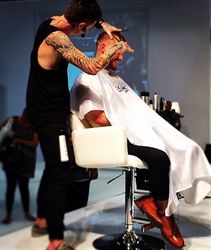6 Cutting Tips from Hattori Hanzo’s Justin Thomas
As a platform artist, educator and artistic director with Hattori Hanzo Shears, Justin Thomas is a busy guy. His clientele at his downtown Sacramento salon includes models, actors and A-List musicians. He’s been backstage at NYFW and on the main stage at some of the biggest hair shows in the industry. People come from all over the world to sit in Justin’s chair and have him change up their style.
That’s why Sport Clips flew Justin out to Vegas for the National Huddle in May to teach a private, hands-on training session for a few of their student artists. During the class, Justin shared cutting and styling tips, tricks of the trade and offered insight into the world of fast-paced and specialized cutting and barbering he’s grown accustomed to at his busy salon in Sacramento.

BTC sat down with Justin after the class to get the lowdown on some of his most “ah-ha” cutting tips. Here are our top six picks.
1. When blending lines for a non-tapered men’s cut using the scissor-over-comb technique, make sure you hold the comb at a 90-degree angle to the head. Many stylists tend to turn their comb to a 45-degree angle assuming it will help, which is counterproductive when attempting to achieve a cleaner look and will result in gaps.
2. When creating hard lines, shears are more effective when you use the muscle in the thumb for radial retraction. To ensure a cleaner, more accurate cut, the shear should be turned inward toward the base of the thumb. Make sure to keep your fingers flat and only move your thumb. This will help the shears operate efficiently with only one moving blade. The stationary blade becomes the guide line for the hair section.
3. Some stylists assume shears can only create a soft, “shear” look. In reality, shears can be used to generate the same look as clippers as long as you follow the fundamentals of the stationary horizontal blade with the comb to 90 degrees.

4. Starting just below or at the parietal ridge to establish your guide, then elevate subsequent sections beneath each previous section for a traveling guide to create a 90-degree look in the most efficient way. Cutting from the bottom to the top expecting the same result is like starting in the front for a graduated bob.
5. When dealing with hard line guidelines, remember that elevation is merely the horizontal version of overdirecting. For example, when creating a clipper look, you should use elevation the same way you would overdirection in any other arena.
6. For certain hair types, it can be faster to use shears than clippers. This is because the clipper guard is essentially a broad comb, and sometimes it’s tough to lift the hair with that device. When using shears and a cutting comb, you have more control when lifting the hair. If your sections are accurate and you utilize a traveling guide, you can get through the cut faster than with a standard clipper/guard.







